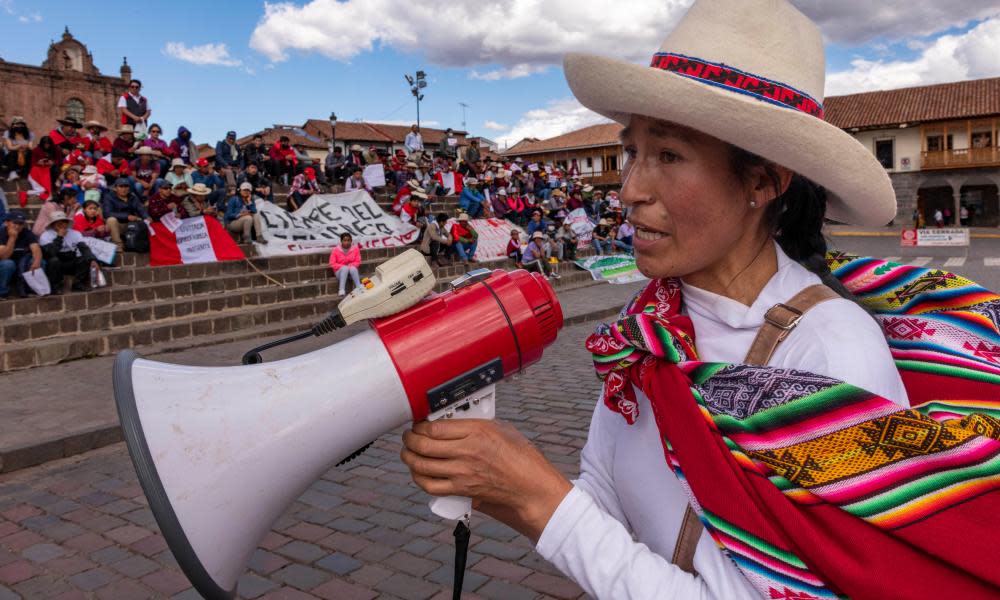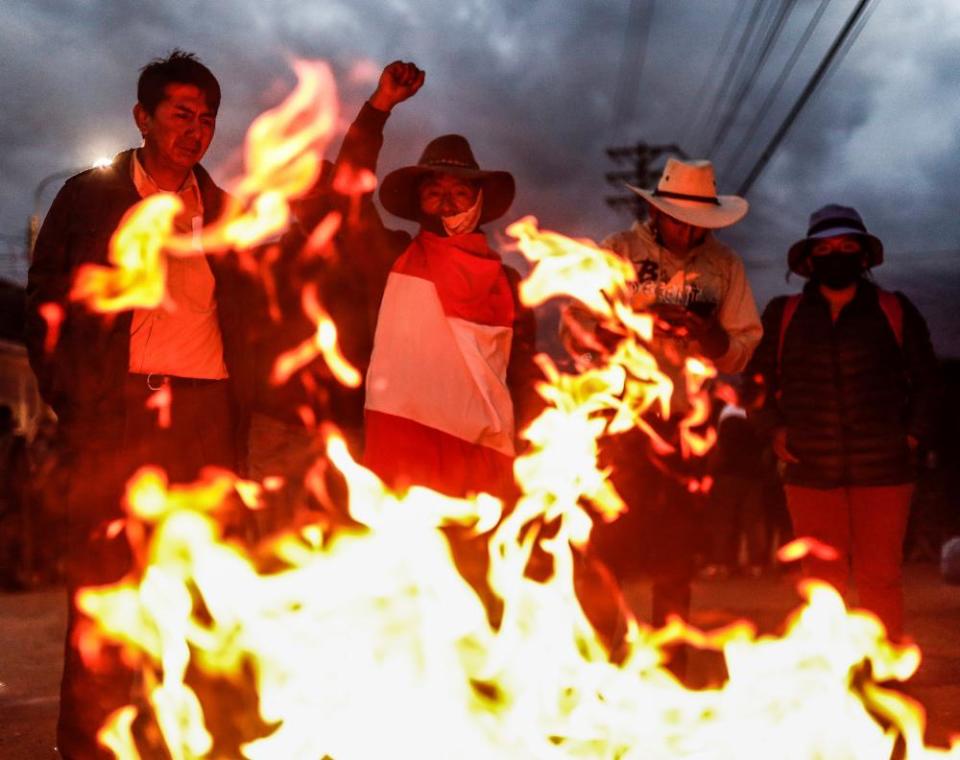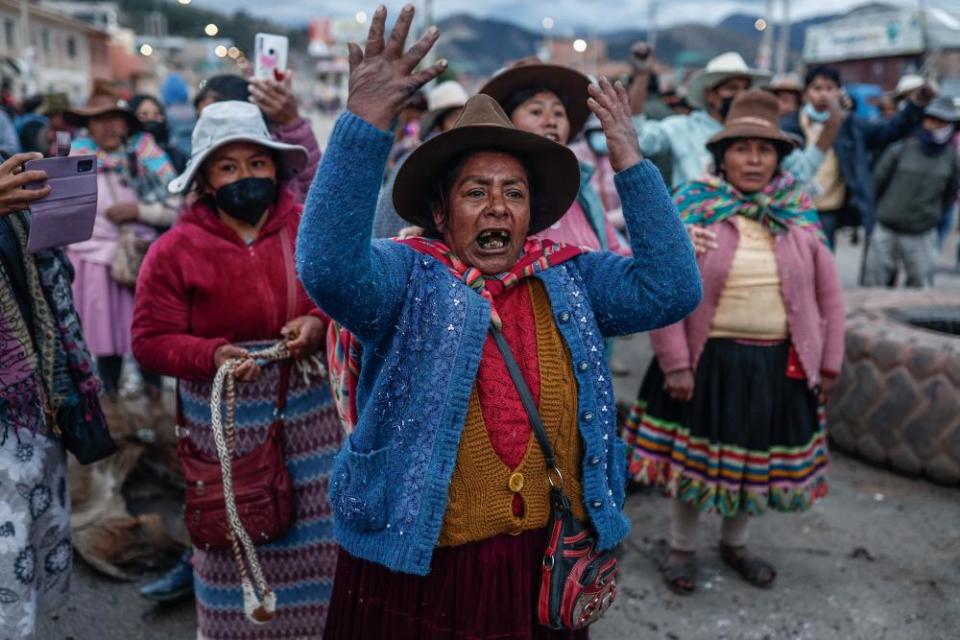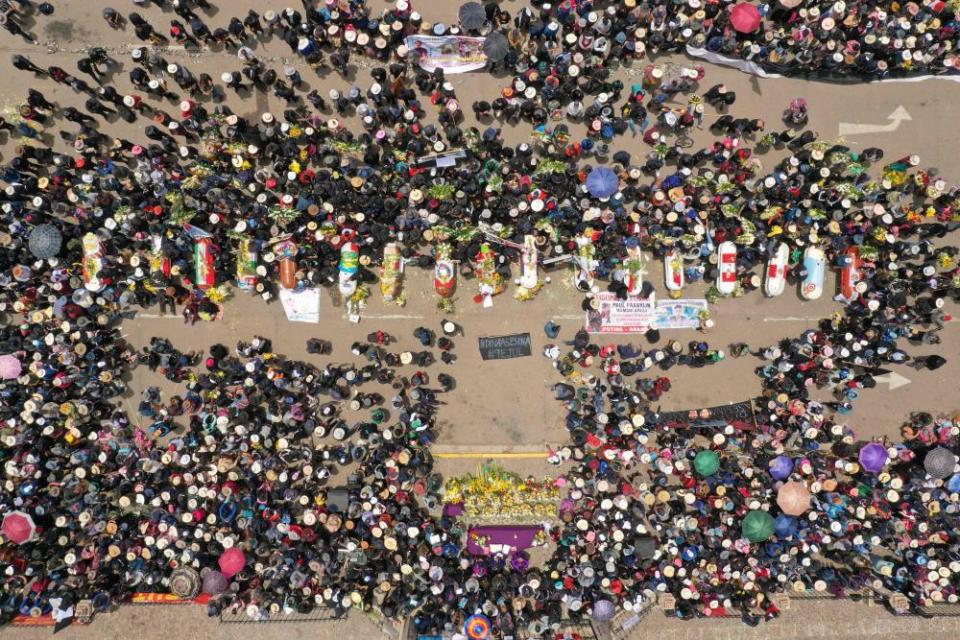‘We’ll fight until the end’: a journey through the centre of Peru’s uprising

One by one, the rebel campesinos clambered up to the improvised podium they had built atop a 6ft earth barricade, to declare their determination to topple the president of Peru.
“Brothers and sisters, right now our Peru needs us more than ever,” Nilda Mendoza Coronel, a 35-year-old farmer, told hundreds of strikers who had gathered under a ferocious morning sun.
“We’ll fight until the very end, carajo!” Mendoza bellowed through a megaphone. “No one will stop our struggle!”
Another speaker, Aparicio Meléndez, urged the crowd in the Andean town of Sicuani to ignore reports that army troops were en route to extinguish their revolt.
“We’ll stay here until they’ve spent their very last bullet,” the 55-year-old grazier vowed as he looked out on the protest blocking the 940-mile highway through the Peruvian Andes.
A two-word rallying cry had been painted on to the tarmac behind the barricade: “People’s insurgency.”

Sicuani is at the heart of the seven-week-old insurrection against Peru’s president, Dina Boluarte, and the country’s political establishment that began in early December after its leftist president, Pedro Castillo, was unseated and arrested after being accused of trying to stage a coup.
Strange and violent political winds have been buffeting Latin America and the Caribbean of late, with a far-right uprising in Brazil, political and social meltdown in Haiti, and protests after the arrest of one of Bolivia’s most prominent opposition leaders. But nowhere has the turmoil been more widespread or deadly than in Peru, where at least 58 lives have been lost since Castillo’s dramatic demise.
Huge swaths of South America’s fourth most populous country have been paralysed by protests and roadblocks since Castillo’s downfall, as his supporters – and those outraged at the government’s deadly response – hit the streets to demand Boluarte’s resignation, fresh elections and justice for the dozens allegedly killed by security forces.
The Guardian travelled through the most affected region, between the Andean cities of Cusco and Juliaca – where 17 people were killed in the worst day of violence – to hear the voices of the mutiny against the Peruvian government.
Related: ‘We feel betrayed’: Peruvians on anti-government protests
The gruelling 210-mile journey took three days and involved navigating scores of checkpoints guarded by campesino protesters, as well as hundreds of barricades made from boulders, tree trunks, dilapidated vehicles, glass and scrap metal.
Beyond the roadblocks, it was also a journey through the profound social inequality, grinding poverty and discrimination that lie behind the explosion of rural anger against what many protesters call the corrupt, self-serving and largely white political establishment in the capital, Lima.
“It’s as if we aren’t humans … It’s as if we are worth nothing,” said Raúl Constantino Samillán Sanga, whose 30-year-old brother was gunned down in Juliaca during clashes between police and protesters. “The whole of the Andes is now saying we’ve had enough – this must change.”
The trip through the centre of Peru’s political earthquake began in Cusco, once the capital of the Inca empire and, today, the South American country’s most important tourist destination, with nearly 3 million visitors each year.

The tourists have vanished since the uprising began, with Cusco’s airport repeatedly shut down by authorities and the nearby Machu Picchu closed earlier this month.
“Everyone’s on edge and worried and a bit scared too,” said Hannah Jenkinson, a British fashion designer who runs a boutique in Cusco’s now largely deserted historic centre.
A few streets away, hundreds of demonstrators marched towards the plaza where in the 18th century the Indigenous leader Túpac Amaru was quartered and beheaded after rebelling against Spanish rule.
“She’s going down! She’s going down! The murderer’s going down!” the crowds chanted of Boluarte as they surged through Cusco’s cobbled streets waving Peru’s red and white flag.
Twenty-five miles south-east of Cusco, past pre-Incan ruins and eucalyptus-dotted mountains, lay the village of Villahermosa – the location of the first major roadblock along Peru’s Route 3S highway.
Dozens of villagers, including elderly women clutching traditional huaraca whips woven from alpaca fleece, had blocked the road with tree trunks and tyres to express their fury at decades of government neglect and the recent wave of killings, most of which have been blamed on security forces.
Juvenal Luna Jara, 22, said he had joined the rebellion one week earlier, incensed that so many protesters had been killed in Peru’s long-neglected rural south, which was at the centre of the brutal 12-year war waged by the Shining Path guerrilla group. As he saw it, the majority of lives were lost in such regions because provincianos (country folk) were considered second-class citizens, or worse. “It’s as if they were killing dogs,” he fumed.
Hours earlier, Boluarte had implored protesters to accept a nationwide truce. But there was no hint of compromise in Villahermosa as farmers gathered to vent their rage at the president’s role in the ousting of Castillo, a former union leader who was born into poverty and was propelled into the presidency in 2021 by impoverished rural voters in places such as this.
“If there’s no solution, the struggle will go on,” the villagers roared before the Guardian’s vehicle was allowed to continue its journey.
In village after village along the boulder-strewn highway, the message was the same, as disillusioned and downtrodden farmers gathered by their blockades to offer impassioned speeches about the state of their nation and how their resource-rich mining region had been milked for profits that were never seen.
Dina Quispe wept as she denounced how Peruvian authorities had branded the protesters narco-funded terrucos (terrorists) and met their call for political change with repression and bloodshed.
“We have been humiliated and forgotten,” said the 41-year-old saleswoman from the community of Checyuyoc. “They are killing our brothers with bullets.”
Through her tears, Quispe voiced disgust that she shared a first name withPeru’s first female president. Boluarte has become a lightning rod for far deeper disillusionment with the broken politics of a country that has had seven presidents in the last six years and where a quarter of the population struggle to properly feed themselves.
Quispe said to reporters: “Please, take this voice of protest from deepest and humble Peru [to the world].”

A few miles away in Sicuani, a town now almost completely cut off from the outside world by the roadblocks, hundreds of Quechua women wearing sombreros, pollera skirts and dazzling quilts were on the march.
“We are fighting for our future and the future of our children and our grandchildren,” said Roxana Chahuanco, 40, as locals prepared to debate their next move after the government announced it would deploy troops to clear the roads.
There, Mendoza Coronel evoked the Indigenous martyrs Túpac Amaru and his wife, Micaela Bastidas, as she urged locals to intensify their peasant rebellion against the “corrupt” Lima elites. “They look down on us because we are the children of campesinos and for being men of the fields,” she said.
At the next village, a cow’s skull had been placed on a pole above a barricade fashioned from two heaps of rubble and earth. “It’s Dina,” joked one of the women policing the checkpoint.
From Sicuani, the highway climbed even higher into the Andes towards the spectacular 4,300-metre border with the department of Puno, where Aymara Indigenous communities are also in revolt against the new government.
Boluarte further infuriated the region’s inhabitants last week when she told foreign journalists “Puno isn’t Peru” – a declaration the president subsequently claimed had been misunderstood.
“We are Peruvians,” said one woman guarding a roadblock outside the town of Ayaviri. “It was in Puno that the Inca empire was born.”

After Ayaviri, the highway descended towards Puno’s largest city, Juliaca, a dilapidated and edgy mining and smuggling hub, where anti-government protests continue to rage as local families mourn their dead.
Behind a metal door decorated with a black ribbon of mourning sat María Ysabel Samillan Sanga, who lost her younger brother one Monday in early January.
Marco Antonio Samillán Sanga was a medical student who had been working as a volunteer medic in Juliaca when protesters tried to storm the city’s airport and security forces responded with live ammunition.
The 30-year-old student was shot through the heart as he attended to a boy who had inhaled teargas – one of at least 17 people to die in Juliaca that day. “It was a massacre,” said his sister. “There is no other word for it.”
Samillán Sanga wept as she remembered how her brother had worked his way out of extreme poverty and into medical school. He had dreamed of becoming a neurosurgeon and creating health programmes for Puno’s rural poor.
“Right now, I feel like I’m being obliged to live … If it was up to me, I’d die too because there are days I just cannot cope with this pain,” she said, tears coursing down her cheeks.
Samillán Sanga also saw prejudice and discrimination at the root of her brother’s death and Peru’s uprising. “We have feelings. We are humans. We feel. We cry. We have emotions. And we are in pain,” said her brother, Raúl Constantino.
The family said they feared government reprisals for speaking out but would not be silenced. “I hope someone reads this and thinks: how is the Samillán Sanga family?” said María Ysabel. “Because the truth is we have been shattered. My family will never be the same again.”
Related: Violent protests in Peru evoke memories of darkest days of civil war

 Yahoo News
Yahoo News 
